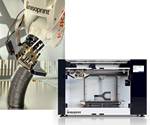Post Cure: Parallel winding technique demonstrates CFRP anisogrid design optimization
Over the years, CIRA has demonstrated its patented CFRP parallel winding technique in a variety of ways for space applications. The lattice structure for the Vega-C launcher stage is a prime example.
Source | Avio/CIRA
Over the last two decades, (Capua, Italy) has modified and refined its patented parallel winding technique, which can achieve scalable, interlaced, carbon fiber-reinforced polymer (CFRP) anisogrid lattice structures.
The process involves a combination of dry fiber robotic filament winding for helical ribs, and parallel winding for hoop ribs. Simultaneous helical winding around pins and parallel hoop winding quickly and efficiently achieves interlacing of the ribs without the need for cutting tows, nor dummy helices, between hoops. The completed dry interlaced preform is then vacuum bagged and infused with resin, and finally cured in or out of autoclave, depending on resin and part requirements.
Lattice winding guarantees homogeneous rib sections through the crossing nodes without the typical distortion seen with prepregs. Also, even if the rib fiber volume fraction is limited to near 35%, stiffness and strength properties are still high, achieving 20% mass reduction with respect to other composite configurations in cases of high compressive load.
Over the years, CIRA has demonstrated the technologies’ capabilities to produce everything from large interstage, central tubes and payload adapters to long booms for large, deployable antennas for medium-class satellites.
Shown here is the Vega-C launcher Interstage 2/3, measuring 2.4 meters in diameter and 2 meters long. It is now produced serially by (Colleferro, Italy) using CIRA’s technology, which is operative at Avio’s facility.
.
Related Content
-
Composites end markets: New space (2025)
Composite materials — with their unmatched strength-to-weight ratio, durability in extreme environments and design versatility — are at the heart of innovations in satellites, propulsion systems and lunar exploration vehicles, propelling the space economy toward a $1.8 trillion future.
-
Rocket Lab begins installation of large AFP machine for rocket production
The 99-ton AFP machine, custom-designed and built by Electroimpact, is claimed to be the largest of its kind, expecting to save around 150,000 manufacturing hours in the Neutron rocket’s production process.
-
NASA launches composite solar sail into space
Sunlight-based propulsion system, supported by carbon fiber-reinforced booms, will undergo weeks-long testing to demonstrate and verify its capabilities.






